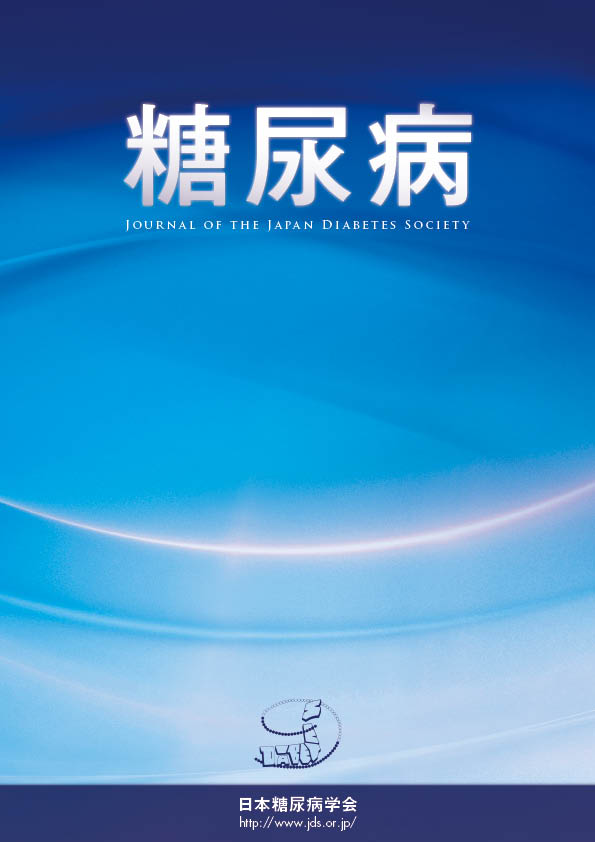
- |<
- <
- 1
- >
- >|
-
Takaaki Matsuoka2020 Volume 63 Issue 9 Pages 589
Published: September 30, 2020
Released on J-STAGE: September 30, 2020
JOURNAL FREE ACCESSDownload PDF (85K) -
Naoki Shimo, Takaaki Matsuoka2020 Volume 63 Issue 9 Pages 590-593
Published: September 30, 2020
Released on J-STAGE: September 30, 2020
JOURNAL FREE ACCESSDownload PDF (1103K) -
Kazutaka Tsujimoto, Tetsuya Yamada2020 Volume 63 Issue 9 Pages 594-597
Published: September 30, 2020
Released on J-STAGE: September 30, 2020
JOURNAL FREE ACCESSDownload PDF (257K) -
Ryo Suzuki2020 Volume 63 Issue 9 Pages 598-600
Published: September 30, 2020
Released on J-STAGE: September 30, 2020
JOURNAL FREE ACCESSDownload PDF (237K) -
Isao Usui2020 Volume 63 Issue 9 Pages 601-604
Published: September 30, 2020
Released on J-STAGE: September 30, 2020
JOURNAL FREE ACCESSDownload PDF (257K) -
Masato Iwabu, Miki Okada-Iwabu, Toshimasa Yamauchi2020 Volume 63 Issue 9 Pages 605-608
Published: September 30, 2020
Released on J-STAGE: September 30, 2020
JOURNAL FREE ACCESSDownload PDF (223K)
-
Naoko Kurooka, Jun Eguchi, Mari Ashida, Michiko Nakajima, Jun Wada, Hi ...2020 Volume 63 Issue 9 Pages 609-617
Published: September 30, 2020
Released on J-STAGE: September 30, 2020
JOURNAL FREE ACCESS[AIM] Medication adherence is closely related to glycemic control in type 2 diabetes patients. To evaluate the association of medication adherence with glycemic control in type 2 diabetes patients, we investigated the adherence rate and degree of adherence required to achieve a certain treatment goal. [METHODS] A self-assessment questionnaire survey was conducted in 1022 patients recruited from among hospital outpatients. The medication adherence rate and degree were assessed by self-reported data. The medication adherence score evaluated the medication adherence degree on a scale of 1 to 5 (1=often, 2=sometimes, 3=occasionally, 4=almost never, 5=never). The medication adherence rate evaluated the percentage of medicines used. [RESULTS] Seventy-five percent of patients were considered adherent to their medication. Female sex, age > 70 years old and 1 dose daily were significantly associated with medication adherence. Furthermore, a ≥95 % adherence rate was related to a hemoglobin A1c < 7.0 %. An adherence rate of 95 % matched an adherence score of 4. [CONCLUSION] The present study showed that female subjects, those > 70 years old and those with once-daily medication were more adherent to their medication than others. A more than 95 % medication adherence rate is required to achieve therapeutic goals in type 2 diabetes patients.
View full abstractDownload PDF (690K)
-
Tomoko Suzuki, Junnosuke Miura, Aki Katamine, Satoshi Takagi, Toshio O ...2020 Volume 63 Issue 9 Pages 618-625
Published: September 30, 2020
Released on J-STAGE: September 30, 2020
JOURNAL FREE ACCESSWe herein report a case of type B insulin resistance in which the therapeutic efficacy was evaluated by intermittent scanning continuous glucose measurement (isCGM). A 55-year-old Japanese man was diagnosed with type B insulin resistance and systemic scleroderma based on the presence of concomitant hyperglycemia and hyperinsulinemia, positivity for both anti-insulin receptor antibody (anti-IRAb) and anti-U1-ribonucleoprotein antibody, and specific physical findings. Treatment for hyperglycemia with an α-glucosidase inhibitor and glucagon-like peptide-1 receptor agonist was unsuccessful; immunosuppressive therapy with prednisolone and cyclosporine was therefore initiated. Between days 15 and 32 of immunosuppressive therapy, the serum immunoglobulin G level, fasting blood glucose (FBG) level, anti-IRAb inhibition rate, and average daily glucose concentration sequentially began to decrease. Finally, on day 41, the patient tested negative for anti-IRAb. During treatment, isCGM showed diurnal variation in blood glucose levels. Before the introduction of immunosuppressive therapy, the FBG and blood glucose levels after breakfast decreased, and the blood glucose levels fluctuated markedly between 0 and 8 AM. After the introduction of immunosuppressive therapy, the daily fluctuation in the blood glucose levels decreased. In this case, long-term isCGM was useful for determining the efficacy of immunosuppressive therapy.
View full abstractDownload PDF (517K) -
Daigo Saito, Yoichi Oikawa, Yuya Yano, Atsushi Satomura, Yuichi Ikegam ...2020 Volume 63 Issue 9 Pages 626-633
Published: September 30, 2020
Released on J-STAGE: September 30, 2020
JOURNAL FREE ACCESSA 61-year-old woman treated with insulin therapy who had been diagnosed with anti-GAD antibody-positive acute-onset type 1 diabetes (AT1D) 5 years earlier was admitted to our hospital with dementia-like symptoms. Her blood test revealed macrocytic anemia and vitamin B12 deficiency. Thereafter, atrophic glossitis and atrophic gastritis were confirmed, and anti-gastric parietal cells antibodies were detected, leading to the diagnosis of pernicious anemia (PA) associated with AT1D. A combination of type 1 diabetes and PA has been observed, typically in cases of autoimmune polyglandular syndrome type III (APS III) with slowly progressive insulin-dependent diabetes mellitus (SPIDDM). Because this patient had no history of autoimmune thyroid diseases, the diagnosis of APS III was excluded. Furthermore, there have been no reports of non-APS III with correctly diagnosed autoimmune-mediated AT1D associated with PA other than our case at least in Japan. The mechanism underlying the combination of autoimmune-mediated AT1D and PA may be immunologically distinct from that of SPIDDM and PA in previous APS III cases.
View full abstractDownload PDF (384K)
-
Masao Toyoda, Takashi Murata, Masanori Abe, Kiminori Hosoda2020 Volume 63 Issue 9 Pages 634-635
Published: September 30, 2020
Released on J-STAGE: September 30, 2020
JOURNAL FREE ACCESSDownload PDF (204K)
-
2020 Volume 63 Issue 9 Pages 636-672
Published: September 30, 2020
Released on J-STAGE: September 30, 2020
JOURNAL FREE ACCESSDownload PDF (1138K)
- |<
- <
- 1
- >
- >|